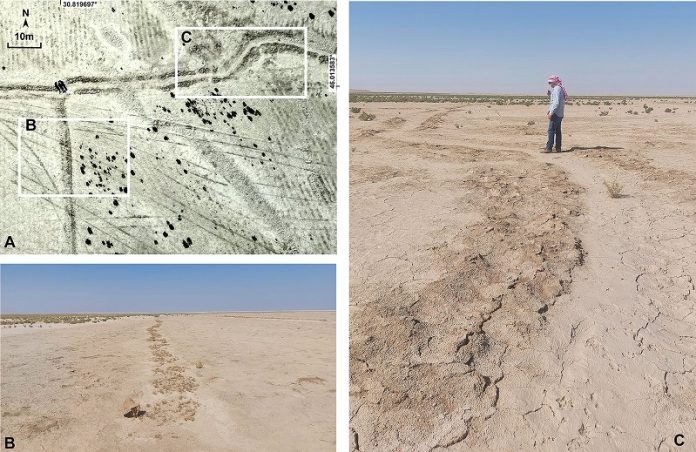
Ground-truthing of the remote sensing work: A) drone images show two minor irrigation canals; B & C) photographs of the two small canals (figure by authors). Credit: Antiquity (2025).
Archaeologists have discovered a massive and well-preserved network of ancient irrigation canals in southern Mesopotamia, providing new insights into how early civilizations managed water for farming.
The discovery was made in the Eridu region, near present-day Basra, Iraq, and dates back to as early as the sixth century BC.
The research team, led by geoarchaeologist Jaafar Jotheri, found that this ancient water system existed for centuries, with farmers using it to bring water from the Euphrates River to their fields.
This discovery helps scientists understand how early societies adapted to their environment to grow food successfully.
The region of Eridu has remained largely untouched for centuries because the Euphrates River changed its course in the early first millennium BC.
This left the area dry and abandoned, unlike other parts of Mesopotamia, where newer canals and river sediments buried older irrigation systems.
Because of this, the ancient canals in Eridu have remained well-preserved, giving researchers a rare opportunity to study an early farming landscape.
Using satellite images, drone photography, and field surveys, the team mapped over 200 main canals that once carried water from the Euphrates.
They also identified more than 4,000 smaller branch canals connecting to over 700 ancient farms.
The irrigation system reveals the impressive engineering skills of ancient Mesopotamian farmers. They used the natural landscape to direct water efficiently.
For example, they took advantage of high riverbanks (levees) to guide water downhill into surrounding fields.
They also created small breaks in these levees, called crevasse splays, to distribute water evenly across the land.
This allowed crops to grow on both sides of the river, though the northern side appears to have been farmed more extensively.
Maintaining such an advanced irrigation network would have required significant labor and expertise. The system evolved over time, with different parts being used at different periods.
This study is just the beginning of a deeper exploration of Mesopotamian farming. Researchers plan to date individual canals to track changes in irrigation techniques over time.
Comparing the canal layouts with descriptions found in ancient cuneiform texts may also provide more information about agricultural management in the region.
The findings highlight the ingenuity of ancient civilizations and their ability to adapt to changing environments. Understanding how they managed water resources thousands of years ago may even provide lessons for modern water conservation.
The study has been published in the journal [_Antiquity_](https://doi.org/10.15184/aqy.2025.19).